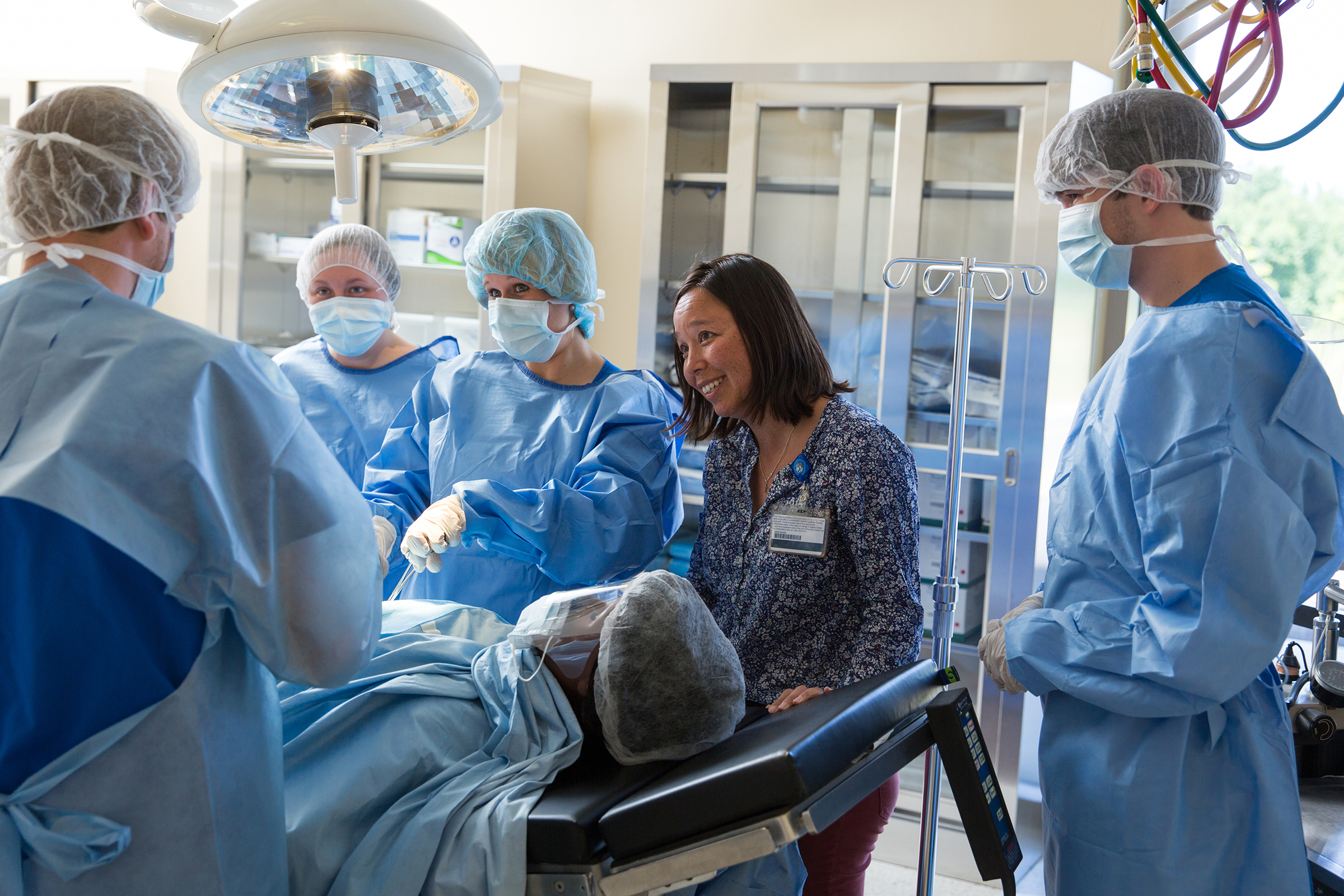Mary Medendorp talks with Wallace State Community College nursing students as they prepare for a simulation inside the Simulation Center’s operating room. Medendorp recently earned her certification as a Simulation Educator from the Society for Simulation in Healthcare. As part of her duties, Medendorp plans and runs simulation exercises for the allied health programs at Wallace State who use the Simulation Center at the School of Nursing and Center for Science.
HANCEVILLE – Mary Medendorp, the simulation coordinator for Wallace State Community College’s Nursing program, recently achieved her certification as a Simulation Educator from the Society for Simulation in Healthcare.
The process for achieving certification included completing an application packet that included showing work experience in simulation for at least two years, a current job description, proof of professional development courses taken within the specified time frame and three references. Then Medendorp had to be approved to sit for the certification exam.
“The test is 115 questions in two hours,” Medendorp said. The exam blueprint was split into five sections, with each assigned a certain weight for grading purposes. The section of Educate and Assesses Learners Simulation accounted for 52 percent of the overall score, followed by Demonstrate Knowledge of Simulation Principles, Practice, and Methodology for 34 percent. The remaining 14 percent was split between Manage Overall Simulation Resources and Environments, Domain, and Engage Scholarly Activities.
“The test is a lot on the theories and what will you do in this situation type things,” she said.
As the simulation coordinator at Wallace State, Medendorp organizes all of the simulation exercises and exams for not only students in the nursing program, but for other Allied Health programs at Wallace State.
“Simulation is very important, especially being for healthcare students, because they get a safe learning environment for a clinical setting,” she said. “I see it as patient safety, because they get to practice but they don’t have the potential of harming a real person. So they can make whatever mistakes they’re going to make or see how they’re interacting with the patients, so it’s a great learning tool. They get to put their critical thinking, what they’re learning in lecture and skills all together before they get to a real person.”
During simulations at Wallace State, students work with other students during exercises controlled by Medendorp and their instructors from the control room. The instructors can have the mannequins present different symptoms that the students must evaluate to make a diagnosis and/or suggest treatment. Every simulation is recorded with video and audio. At the end of the simulation, the students are debriefed as the instructors go over the recording to show them how well they did and in what areas they need to improve.
“Most of the Health Science programs utilize simulation because we can see what the students are going to do before they get to a real person and correct anything that needs to be corrected before they get to that real person,” Medendorp said.
While most programs use the simulation center individually, Medendorp also arranges interdisciplinary simulations where multiple programs work together during a simulated disaster of some kind. An upcoming interdisciplinary simulation will include about eight of the Health Science programs.
“I think of scenarios that can involve multiple programs,” she said. She usually has about seven to eight scenarios during each simulation. A motor vehicle accident is a “tried and true” scenario that usually makes it into the simulation. She said she also tries to include scenarios that are relevant to what may be going on in the world at the moment.
“It is very fun, because instead of standing up in lecture for four hours, I get to show them how it’s applied, so that’s pretty cool,” she said.
Medendorp said the certification is validation that Wallace State has credible instructors instructing their students.
“We’re very proud of our state of the art simulation center and that Ms. Medendorp has achieved her certification as a Simulator Educator,” said Lisa German, Dean of the Health Science programs at Wallace State. “Our facility coupled with exemplary educators like Ms. Medendorp allow us to provide excellent clinical simulation opportunities for our Health Science students.”
Established in 2004 by professionals using simulation for education, testing, and research in health care, the Society for Simulation in Healthcare (SSH) seeks to improve performance and reduce errors in patient care through the use of simulation. SSH membership includes physicians, nurses, allied health and paramedical personnel, researchers, educators and developers from around the globe. SSH fosters the improvement and application of simulation–based modalities such as human patient simulators, virtual reality, standardized patients and task trainers.
Wallace State Community College has the highest number of health science programs among all community colleges in the state. There are 18 Health Science programs to choose from at Wallace State. They include: Child Development, Dental Assisting, Dental Hygiene, Diagnostic Imaging, Diagnostic Medical Sonography, Emergency Medical Services, Health Information Technology and Medical Coding, Human Services, Medical Assistant, Medical Laboratory Technician, Nursing (hybrid and part-time options offered), Occupational Therapy Assistant, Patient Care Specialist, Pharmacy Technology, Physical Therapist Assistant, Polysomnography (Sleep Study), Respiratory Therapy, and Therapeutic Massage. The Child Development, Health Information and Medical Coding, Pharmacy Technology and Polysomnography are all taught completely or almost all through online courses.
For more information about Wallace State, call 256-352-8000 or visit www.wallacestate.edu.




















